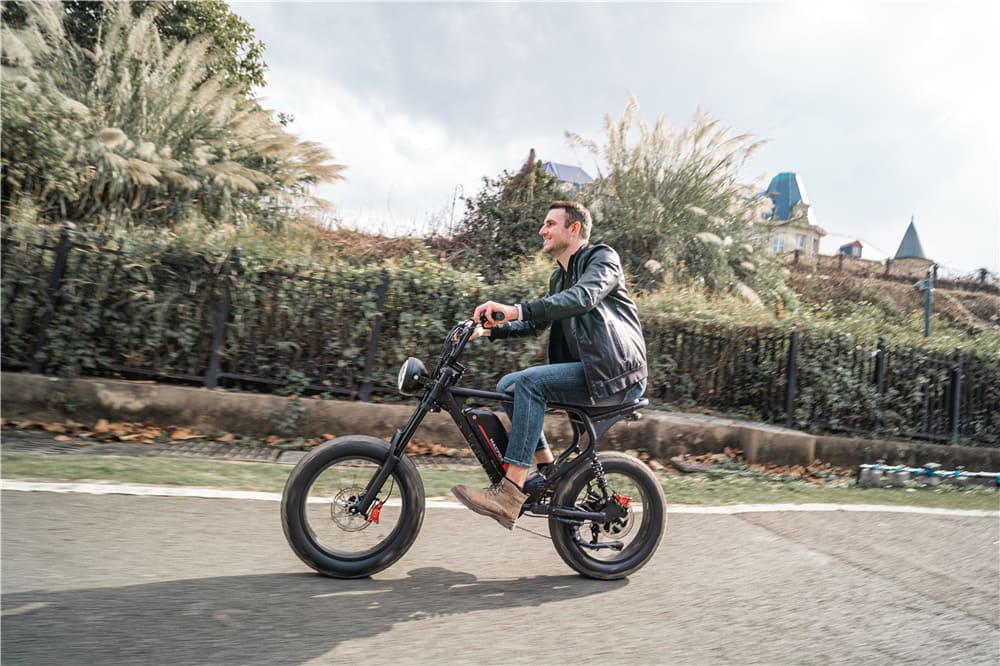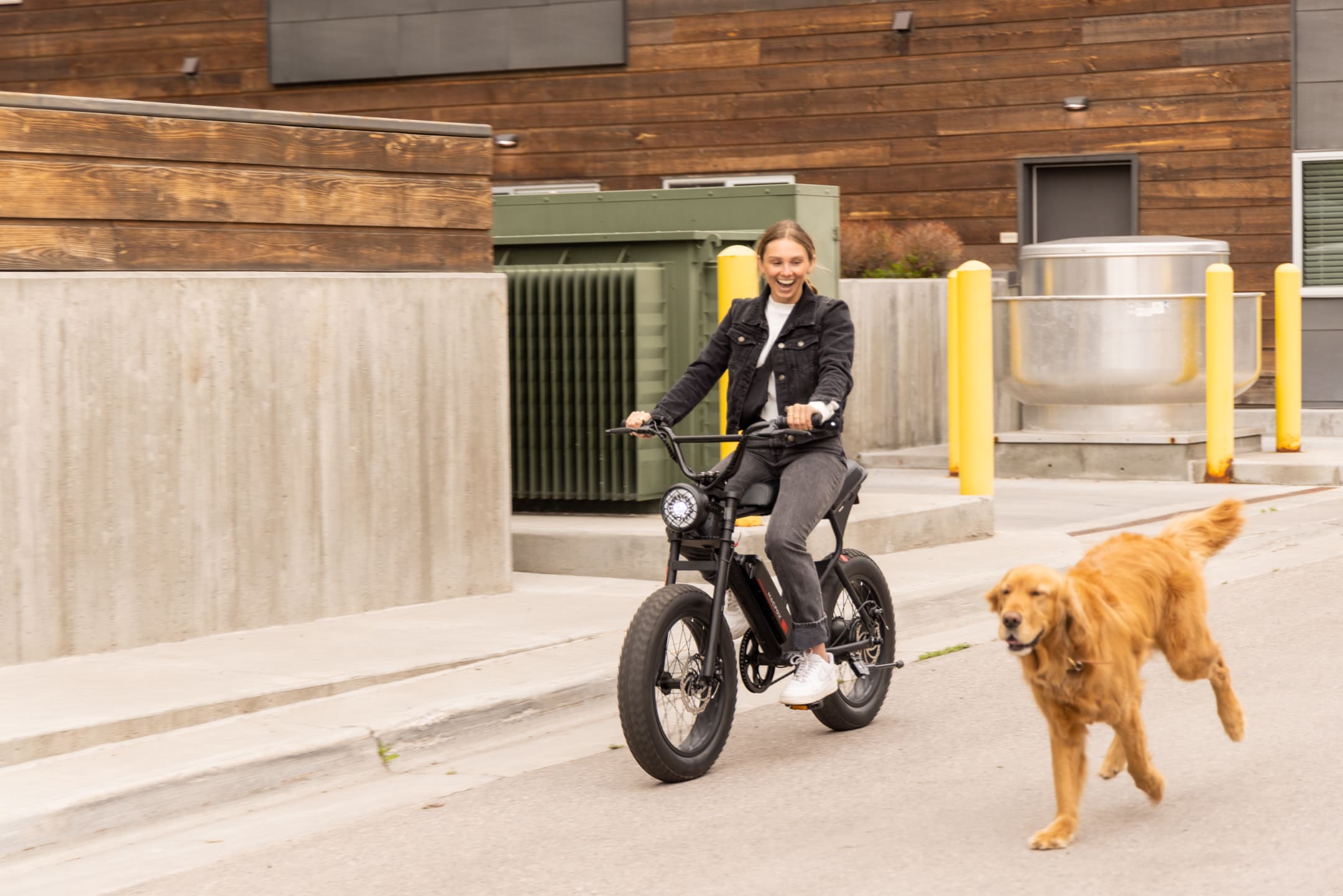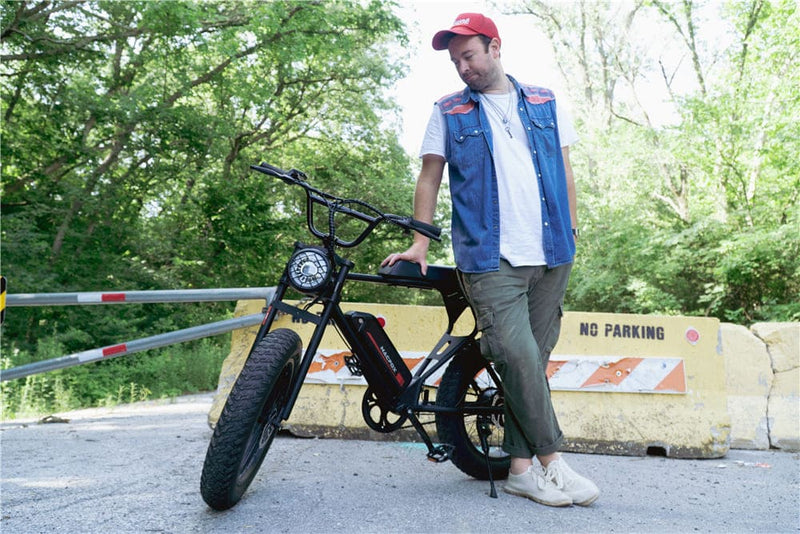E-bikes have revolutionized our riding experiences, combining power, performance, and pleasure. When selecting your ideal ebike model, the choice between hardtail and Softail models can be crucial - they have different ride dynamics that impact comfort and control on various terrains. In this blog post, we dive deep into these options and their cost, maintenance requirements, and durability to assist in finding your ideal ride! Let's get rolling! Let's find your ideal ride.
Hardtail and Softail Frame Design Are Explored in Detail

Understanding the design of hardtail and softail e-bike frames is essential to matching one to your riding style and terrain. Not only can the frame shape impact weight and handling, but it can also improve comfort and efficiency across various terrains.
Hardtail Frame
A hardtail frame stands out for its efficiency and simplicity, thanks to its lack of rear suspension. This design directly converts pedaling power into motion, making it especially well suited to smooth terrain where its responsiveness and lightweight can be fully appreciated. Hardtail frames also create a more connected riding experience where the cyclist feels in tune with the path beneath them; this direct connection makes these frames ideal for cyclists who prize precision and speed on both paved roads or gentle off-road trails where its reduced weight and enhanced pedaling efficiency can shine brightly.
Softail Frame
In contrast to hardtail frames, the Softail features a rear suspension system designed to absorb vibrations and shocks caused by uneven terrains. It significantly improves ride comfort by helping the bike glide over obstacles and rough patches with less discomfort for its rider. While this does add weight and complications in maintenance due to additional parts being present on its bodywork, adventurers who regularly tackle rugged trails may appreciate how effectively this softail's suspension absorbs impacts, which can make an enormous difference in ride quality and comfort!
Comparison of Riding Comfort, Stability, and Controllability
Frame designs vary considerably in terms of comfort, stability, and controllability, making an impactful statement about how much a rider values the experience and enjoyment they get out of riding their bicycle.
Ride Comfort
A Softail frame stands out regarding ride comfort, providing a buffer against impacts encountered on uneven terrains like rocks and hillsides. The suspension system ensures a more forgiving, comfortable experience that reduces rider fatigue. On the other hand, hardtail frames may offer less cushion on rougher surfaces; however, their lack of rear suspension means less energy wasted due to frame flexing, resulting in an efficient and responsive experience when riding roads or well-kept trails.
Stability
Both designs provide unique advantages when it comes to stability, depending on the riding surface. Softails' rear suspension offers additional support on uneven and rugged terrains by maintaining better contact with the ground, helping absorb impacts that might otherwise throw the bike off course, making them well-suited for technical trails where terrain varies significantly. In contrast, with their lighter weight and simpler design, hardtails offer greater control on smoother terrains thanks to a direct connection to the ground that makes responding quickly to changes easier for agile riding with precision and agility.
Controllability
A bike's ability to be directed by its rider presents advantages and drawbacks when choosing between hardtails or softails for its controllability or how well a rider can direct their bike. Hardtails are easier for beginners or riders on smooth terrain who value direct feedback from their bike. On the other hand, softails, with their heavier weight and dynamic suspension systems, offer better controllability under rougher conditions due to managing reactions to bumps and obstacles more smoothly for a smoother yet controlled ride through technical sections.
Related Reading: Mastering the Right Posture for E-Bike Riding
Terrain and Conditions for Hardtail and Softail E-Bikes
Decisions between hardtail and softail e-bikes shouldn't just be based on personal taste; the selection is also heavily determined by the terrain and conditions in which you intend to ride your e-bike. Each frame design can impact everything from handling and comfort to ride enjoyment and safety.
Terrain
Hardtail e-bikes perform at their best on smooth, well-maintained paths - city streets, bike lanes, or light off-road trails like those found in many parks. Without rear suspension, hardtail designs excel in environments where road surfaces are predictable and obstacles minimal; their directness makes for enjoyable riding on flat or gently undulating terrain where distance and speed rather than technical obstacles present the biggest challenges.
Softail e-bikes, however, are tailored to provide riders with a rough and unpredictable riding experience. Their performance shines on terrain that presents obstacles, variations, and technical demands, such as mountain trails, rocky paths, and uneven surfaces where rear suspension absorbs shocks while maintaining traction - ideal for backcountry exploration or technical trail challenges! For riders seeking comfort and control that a hardtail simply cannot match, softails provide this edge.
Conditions
Your riding conditions are integral to choosing an e-bike type that best meets your needs. Hardtails, with their simple design and lighter weight, are well suited to dry, stable environments where predictable terrain allows riders to focus on speed and efficiency - ideal companions for fair-weather rides where changes in surface texture are minimal and easily navigated.
Softail e-bikes, with their enhanced shock absorption and stability, are better equipped to handle variable and challenging conditions, including wet weather where mud, puddles, and ruts make trails treacherous; environments containing roots, rocks, and ruts, as well as any situation with roots, rocks, and ruts present. Their flexible frame enables them to adapt easily to these unpredictable circumstances for a safer ride while increasing rider comfort for longer durations without constant vibration or shock fatigue.
Cost, Maintenance, and Durability
When purchasing an e-bike, not only should you consider its initial cost, but you should also evaluate long-term maintenance and durability costs. There are significant differences between hardtail and softtail e-bikes in this regard, depending on their design complexity and intended use environment. If you are looking for an electric bike in this area, Macfox Electric Bike is your best choice.
Cost
Hardtail e-bikes, such as the Macfox X1 affordable electric bike, tend to be less costly than their softail counterparts initially due to their simpler designs and lack of additional components and engineering associated with rear suspension systems. The Macfox X1 serves as an accessible entry point without compromising on performance, especially if used primarily on flat terrain. Its design emphasizes efficiency and user-friendliness, making it an excellent choice for riders looking for quality and affordability in one package.
Softail e-bikes typically command higher prices due to their complex designs and suspension technology. Still, this investment is worthwhile for riders who frequently traverse rough and uneven terrain where suspension systems provide greater comfort and control.
Maintenance
Maintenance requirements should also be an essential consideration. Hardtail e-bikes typically require less upkeep over time due to having fewer moving parts and components that can wear out or malfunction over time compared with traditional bikes. Hardtails make an especially good option for those seeking low-maintenance biking solutions.
Softail e-bikes, with their extra components and complexity, often require more frequent and specialized maintenance to keep their suspension systems operating optimally, which may incur extra costs or extend bike downtime if specialist services are necessary. When considering these increased maintenance requirements against any benefits, such as improved ride quality and comfort on challenging terrains, the benefits should outweigh these extra maintenance requirements.
Durability
Durability depends on several factors, including the quality of construction materials used and how a bike is cared for and used. Both hardtail and softail e-bikes can be highly durable and well-maintained when properly cared for within their design limits. However, Softail models may wear quicker due to the demanding environments they were created to handle; for this reason, regular maintenance and part replacement is key in prolonging its life and increasing its lifespan.
Conversely, hardtail e-bikes' simple designs can often lead to greater durability in less demanding conditions, providing reliable service without wear-and-tear concerns or component wear or failure issues. When properly maintained and cared for, a hardtail e-bike could provide many years of reliable service without worry over wear-and-tear or component failure issues.

Additional Insights: Making Your Perfect Choice 🎯
Hey riders! Now that we've covered the fundamentals, let's dive into some practical guidance to help you make the best choice for your needs!
Quick Decision Guide ✨
✅ Choose a Hardtail if you:
- Primarily ride on paved roads and smooth trails
- Want a more affordable option
- Prefer less maintenance
- Love feeling connected to the road
- Are focused on speed and efficiency
- Want a lighter bike for easy transport
- Are new to e-biking and want something straightforward
✅ Choose a Softail if you:
- Often ride on rough terrain or bumpy trails
- Value comfort over speed
- Don't mind regular maintenance
- Have a higher budget
- Plan on long-distance rides
- Want versatility for various terrains
- Have back or joint sensitivity
Real-World Usage Scenarios 🌍
Urban Commuter
If you're planning to use your e-bike mainly for commuting through city streets, a hardtail might be your best bet. Here's why:
- Better efficiency on smooth roads means longer battery life
- Lighter weight makes it easier to carry up stairs or store in apartments
- Less maintenance needed for daily use
- More responsive handling for navigating traffic
Weekend Warrior
For those who work during the week but live for weekend adventures:
- Consider a softail if your trails are rocky or technical
- Go hardtail if your weekend rides stick to rail trails or smooth paths
- Think about whether you'll be riding more on weekdays (commuting) or weekends (trails)
Fitness Enthusiast
Looking to get in shape? Your choice might depend on your fitness goals:
- Hardtail: Better for cardio workouts and efficiency training
- Softail: Easier on joints and better for longer endurance rides
Important Features to Consider 🔍
Battery Range Impact
- Hardtails typically get better range due to:
- Lighter weight
- Less power lost to suspension movement
- More efficient power transfer
- Softails might need larger batteries for equivalent range
Storage and Transport
Think about how you'll store and move your bike:
- Hardtails are typically:
- 2-3 pounds lighter
- Easier to mount on car racks
- Simpler to clean and maintain
- Softails require:
- More storage space
- Stronger car racks
- More careful handling during transport
Weather Considerations ⛈️
Your local climate should influence your choice:
- Hardtails excel in:
- Dry conditions
- Urban environments
- Regular road conditions
- Softails perform better in:
- Wet, slippery conditions
- Varied weather conditions
- Rough road surfaces
Lifestyle Compatibility Check 🎯
Ask yourself these key questions:
- How much time can you dedicate to maintenance?
- Less than 1 hour/month: Consider a hardtail
- Happy to do regular checks: Either option works
- Enjoy bike maintenance: Softail could be fine
- What's your storage situation?
- Limited space: Hardtail
- Garage or dedicated bike area: Either option
- How will you transport your bike?
- Regular car transport: Consider weight limits
- Mostly riding from home: Either option works
- What's your riding schedule?
- Daily commuting: Hardtail might be more practical
- Weekend adventures: Choose based on terrain
Budget Considerations 💰
Let's break down the true cost of ownership:
Initial Purchase
- Hardtail: Generally $300-$800 less expensive
- Softail: Higher initial investment but more versatile
Annual Maintenance Costs (Approximate)
Hardtail:
- Basic tune-up: $50-100
- Tire replacement: $60-120
- Battery check: $30-50
Softail:
- Basic tune-up: $75-150
- Suspension service: $100-200
- Tire replacement: $60-120
- Battery check: $30-50
Long-term Value
Consider these factors:
- Hardtails typically have:
- Lower depreciation
- Fewer parts to replace
- Longer overall lifespan
- Softails offer:
- Better resale value in mountain biking communities
- More versatile use cases
- Higher initial investment but potentially better comfort
Pro Tips for New E-Bike Owners 💡
Test Riding
Before making your final decision:
- Try both types on similar terrain
- Test ride for at least 15-20 minutes
- Bring your regular riding gear
- Test the bike on terrain similar to where you'll ride most
Maintenance Tips
- Regular Checks (Both Types):
- Battery charge levels
- Tire pressure
- Brake performance
- Chain lubrication
- Additional Softail Checks:
- Suspension pressure
- Pivot point maintenance
- Shock absorber condition
Safety Considerations
- Always wear a properly fitted helmet
- Use appropriate lighting
- Consider your visibility in traffic
- Start with easier trails/routes
- Get familiar with your bike's features before challenging rides
Conclusion
Selecting between a hardtail or softail e-bike depends primarily on personal preferences, riding style, and terrain type. Hardtails offer greater simplicity, efficiency, and speed on smoother trails - ideal for urban commuting or light trail riding - while softails boast superior comfort and stability better suited to more challenging terrain. Ultimately, considering your priorities regarding ride comfort, terrain exploration, and budget will lead you toward finding an e-bike that best meets your needs.
E-bike journeys open up a world of opportunities. No matter your riding preference—hardtail or softail—there is sure to be an e-bike that fits. Happy riding!
FAQs
Is a hardtail or softail e-bike better suited for city riding?
Hardtail e-bikes are ideal for city riding due to their lighter weight, easier maintenance requirements, and ability to quickly navigate smooth pavement surfaces.
Does a Hardtail or Softail e-bike require more maintenance?
Softail e-bikes require more frequent maintenance due to their complex rear suspension systems that feature more moving parts that may need repairs or adjustments over time.
Are Softail E-bikes worth their extra costs?
Softail e-bikes may be worth the additional cost for riders who frequently navigate rugged and uneven terrain. The rear suspension provides added comfort and control during challenging conditions.


















